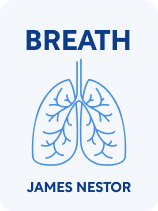

This article is an excerpt from the Shortform book guide to "Breath" by James Nestor. Shortform has the world's best summaries and analyses of books you should be reading.
Like this article? Sign up for a free trial here.
Is it better to breathe fast or slow? How does slowing down your breath affect oxygen absorption?
When we breathe “normally,” we only absorb about 25% of the oxygen we take in. On the other hand, slow breathing lets us absorb more oxygen using fewer breaths—a more efficient process for the whole body that uses less work to produce more energy.
Keep reading to learn about the health benefits of slow breathing, according to James Nestor.
Slow Your Breath Down
Our optimal breath rate is slow—much slower, in fact, than what we’re used to. To explain why this is, we must understand the vital role that carbon dioxide plays in our body chemistry and how breathing slowly will affect our chemical balance. In addition to the benefits of slow breathing, Nestor discusses the importance of breathing less air all at once.
The science we’re taught in school is basically true—we inhale oxygen and exhale carbon dioxide. What’s false is the implication that carbon dioxide is merely a waste product, when in fact it’s a vital part of the chemical exchange that gives the oxygen in our blood access to our organs. As our muscles and organs do more work, they burn energy and create carbon dioxide, which releases oxygen from the hemoglobin in our blood cells. As stated earlier, heavy breathing purges carbon dioxide from the body, which short-circuits the necessary chemical exchange and starves our cells of the very oxygen they need.
| The Right Amount of Carbon Dioxide Most of the carbon dioxide in our bodies is not present in its common chemical state, but as a component of bicarbonate and carbonic acid. Doctors measure the amount of carbon dioxide in the blood in terms of milliequivalents per liter, defining normal levels as being between 20-29 milliequivalents per liter, though a 2018 study suggests that a range of 23-30 might be more accurate. While a certain amount of carbon dioxide is necessary to maintain our body chemistry, a build-up of too much carbon dioxide from shallow breathing can result in respiratory acidosis, a condition in which the body can’t expel carbon dioxide at a fast enough rate. Respiratory acidosis can be caused by asthma, obesity, or diseases that damage the chest’s nerves and muscles. Symptoms of respiratory acidosis include headaches, fatigue, feeling out of breath, and may even become a chronic condition leading to mental problems, hypertension, and possibly heart failure. |
Nestor writes that breathing more slowly doesn’t lower the amount of oxygen in the body, but it does increase the amount of carbon dioxide, allowing more of the oxygen to be absorbed. As a result, oxygen flow to the brain increases, and all our other bodily functions align themselves to work at top efficiency.
(Shortform note: This claim of Nestor’s may be overstated. Research has shown that slow, controlled breathing increases oxygen saturation levels in people with conditions such as chronic heart failure, but others argue that it has no such effect on otherwise healthy people. However, studies confirm that slow breathing increases blood oxygenation for people at high elevations. To what extent this applies at lower altitudes is unclear.)
The idea of breathing more slowly isn’t new. Spiritual practices from all around the world have ritualized slow breathing in the form of meditations, chants, and prayers. Nestor points out that all these disparate traditions, whether Tibetan or Catholic or Native American, have settled on approximately the same ideal breath rate: 5.5 seconds to breathe in, 5.5 seconds to breathe out. This, it seems, is the ideal rate of breath to bring the body and mind into alignment.
(Shortform note: Different breathing practices and their associated benefits vary more than Nestor suggests, though they’re in the same ballpark. Research on long-time yoga practitioners found that they pace their breathing at 3-4 breaths per minute, slower than Nestor’s ideal rate. Studies on heart rate variability, an indicator of cardiovascular health, show that it peaks at a rate of 8 breaths per minute, 50% faster than Nestor recommends. In the relaxation technique called box breathing, you inhale for 4 seconds, hold your breath for 4 seconds, exhale for 4 seconds, and pause for 4 seconds, for a total of 5 breaths per minute.)
Hypoventilation
Some researchers believe that breathing less air can increase the body’s overall performance. Known as “hypoventilation training,” this involves limiting your inhalations during exercise while extending the time you take to exhale. This accustoms the body to higher carbon dioxide levels and trains you to take in less air while resting. Studies have shown that this practice heightens athletic performance and is beneficial to people who suffer from asthma. Patients undergoing hypoventilation therapy developed higher resting carbon dioxide levels and fewer asthma attacks. Nestor admits that hypoventilation isn’t for everyone, in particular people who have emphysema (and therefore, already high levels of carbon dioxide).
(Shortform note: For more information, Nestor points readers to the Association for Research and Promotion of Hypoventilation Training. A study of hypoventilation in basketball players suggests that it improves the reoxygenation of muscles after bursts of exertion such as sprinting, leading to shorter recovery times. However, studies also show that voluntary hypoventilation leads to muscles deoxygenating faster in sprints than in people breathing normally while performing the same activity.)
He also states that no one’s really sure why hypoventilation training works. The leading theory is that it affects the body’s pH level (the body functions best at pH 7.4). Our “normal” practice of overbreathing makes the blood more alkaline, and other organs such as the kidneys have to release chemicals into the blood to compensate, which over time depletes the body’s minerals. Breathing less air, then, resets our pH without putting extra stress on the body’s resources.
(Shortform note: There are many factors besides overbreathing that can alter the body’s pH. Obesity, lung and heart problems, aspirin, and opiates can all make the blood more acidic, while dehydration, vomiting, diuretics, and antacids can make the blood more alkaline. Doctors treat pH imbalances with a variety of medications and therapies, depending on the specific condition, but you can also maintain your pH balance by eating right and drinking enough water.)

———End of Preview———
Like what you just read? Read the rest of the world's best book summary and analysis of James Nestor's "Breath" at Shortform.
Here's what you'll find in our full Breath summary:
- Why you're probably breathing wrong
- The benefits of learning how to breathe properly
- The potentially dangerous side effects of mouthbreathing






